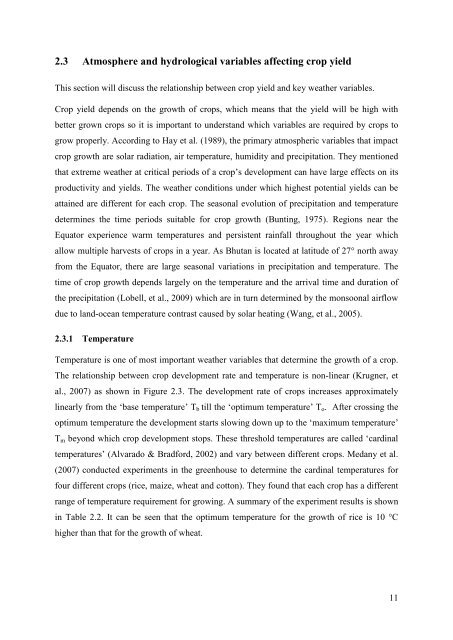UNIVERSITY OF READING - E-Library - WMO
UNIVERSITY OF READING - E-Library - WMO
UNIVERSITY OF READING - E-Library - WMO
Create successful ePaper yourself
Turn your PDF publications into a flip-book with our unique Google optimized e-Paper software.
2.3 Atmosphere and hydrological variables affecting crop yieldThis section will discuss the relationship between crop yield and key weather variables.Crop yield depends on the growth of crops, which means that the yield will be high withbetter grown crops so it is important to understand which variables are required by crops togrow properly. According to Hay et al. (1989), the primary atmospheric variables that impactcrop growth are solar radiation, air temperature, humidity and precipitation. They mentionedthat extreme weather at critical periods of a crop’s development can have large effects on itsproductivity and yields. The weather conditions under which highest potential yields can beattained are different for each crop. The seasonal evolution of precipitation and temperaturedetermines the time periods suitable for crop growth (Bunting, 1975). Regions near theEquator experience warm temperatures and persistent rainfall throughout the year whichallow multiple harvests of crops in a year. As Bhutan is located at latitude of 27° north awayfrom the Equator, there are large seasonal variations in precipitation and temperature. Thetime of crop growth depends largely on the temperature and the arrival time and duration ofthe precipitation (Lobell, et al., 2009) which are in turn determined by the monsoonal airflowdue to land-ocean temperature contrast caused by solar heating (Wang, et al., 2005).2.3.1 TemperatureTemperature is one of most important weather variables that determine the growth of a crop.The relationship between crop development rate and temperature is non-linear (Krugner, etal., 2007) as shown in Figure 2.3. The development rate of crops increases approximatelylinearly from the ‘base temperature’ T b till the ‘optimum temperature’ T o . After crossing theoptimum temperature the development starts slowing down up to the ‘maximum temperature’T m beyond which crop development stops. These threshold temperatures are called ‘cardinaltemperatures’ (Alvarado & Bradford, 2002) and vary between different crops. Medany et al.(2007) conducted experiments in the greenhouse to determine the cardinal temperatures forfour different crops (rice, maize, wheat and cotton). They found that each crop has a differentrange of temperature requirement for growing. A summary of the experiment results is shownin Table 2.2. It can be seen that the optimum temperature for the growth of rice is 10 °Chigher than that for the growth of wheat.11
















